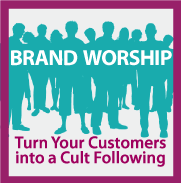A Short History of Branding: A Soap Story
 Once upon a time in a small village, a local soap maker produced his wares and sold them out of his own front door.
Once upon a time in a small village, a local soap maker produced his wares and sold them out of his own front door. For the other locals in the town this was a godsend.
After their weekly bath you could hear them sing, ‘Clean at last! Clean at last!’
As the village became a town, another soap maker arrived.
At first the two artisans were a little wary of each other. There hadn’t been another soap maker in town before.
They soon realized, the town was big enough for the both of them and they happily shared the town’s customers.
A short time later, the General Store received a visit from a travelling salesman. He represented a big soap making company from an emerging city over 100 miles away.
The quality of his generic soap wasn’t quite as good as the handmade ones the locals had been used to, but it was a little cheaper and it was yellow.
At first the locals avoided it, simply because it was different and they didn’t trust ‘different’.
Eventually ‘cheaper’ won over some locals and the new product established a regular clientele – much to the disgust of those who stayed with the hand-made local product.
Some time later, another travelling salesman from a different soap company appeared.
It didn’t take long for a rivalry to emerge between the new soap giants. The Great Northern Soap Company versus the Great Southern Soap Company. There was a discount war, free samples and special offers.
They even started advertising to attract attention, with both companies yelling ‘OUR SOAP IS BETTER!’
The customers loved this. They not only had more choice, they had people craving for their attention too.
But the local soap makers hated it; eventually both of them went out of business.
Not long after, a third soap appeared but it wasn’t from a third company.
The Great Southern Soap Company had produced a new soap.
It looked like the other soaps but came in a bright white box with a beautiful girl on the front. The package was so stunning you could imagine someone making art out of it one day.
And, best of all, it wasn’t just soap, it was called ‘Luxury’.
And, it wasn’t for getting rid of dirt either. It was to ‘make yourself beautiful.’ Or at least, that’s what the pack said.
Yes, it was a bit more expensive but hey, if it’ll make me beautiful… Damn, those extra cents, I’m worth it!
Then some time later, there was a soap explosion. A fourth soap appeared, and then a fifth and then another… There was one for ‘real’ men, one with ‘No Logo’, one with a jet flying to Tahiti on the packet and even one for kids claiming ‘No more fears’.
How could soap be all that?
But all this did was to confuse people. Which soap is the one for me?
Soon the people of the town started to form little groups around the soap they used. The women who drove big cars only used ‘Luxury’. Other women refused to talk to those who bought ‘No Logo’.
And, ironically, the soap for ‘real’ men became a gay icon – they even started making it in funny shapes. They said it helped them enjoy it more.
Some time soon after, a new soap ‘Planet’ appeared.
It wasn’t like any that had arrive
 d in town before. The packet said it wasn’t soap either but a way to save the planet. And, they had the t-shirts to prove it.
d in town before. The packet said it wasn’t soap either but a way to save the planet. And, they had the t-shirts to prove it.They said those other soaps were made with nasty chemicals and that was causing hot weather, endangering animals, killing brain cells and polluting the rivers.
They didn’t want you to just buy the soap. They wanted you to come to a meeting where people stood on soapboxes.
They wanted you to join them in saving the world - one bar of soap at a time!
They wanted you to join them in the charge of the soap brigade!
And that was the end of soap in that town.
Of course, people still used soap, they simply didn’t buy soap for soap sake anymore.
For more on branding get your complimentary copy of Brand Worship: How to Turn Your Customers into a Cult Following from www.BookRapper.com. It's derived from Douglas Atkin's: The Culting of Brands: Turn Your Customers Into True Believers.
Labels: Brand Worship, Branding, History of Branding, The Culting of Brands

